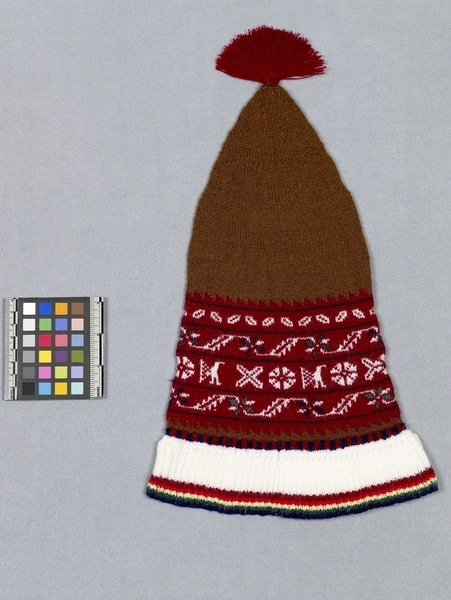Hat Item Number: Sf929 from the MOA: University of British Columbia


Description
A conical stocking cap with a red tassel at the top and a ribbed frill around the bottom, in white with green, yellow, red and dark red edging. The top half is mid-brown and the bottom half has four bands of geometric motifs on a dark red background. Two bands repeat a six part floret connected by oblique stepped lines. One band repeats a left and right slanted ovoid. The third band has birds, circle, cross and butterfly motif. Bottom frill is not a complete circle.
History Of Use
The colour, extent of patterning, shape and the manner in which chullus or caps are worn signal differences in age, sex and status of the wearer. Females wear chullus in early childhood, but only males wear them later in life. Traditionally, knitting is done only by men and boys, formerly for chullus, but recently also for vest fronts, coin purses, gloves, ties, vests and sweaters which are sold to tourists.
Specific Techniques
Plain knitting done circularly on five needles with extra colours carried on the inside for local colour areas.
Narrative
Commissioned by mail from Gonzalo Yucra Huatta for the Museum's collection. It has not been used.
Iconographic Meaning
The range of motifs refers to local geography and landmarks, ecology, fecundity as well as luck. The six part circle refers to the division of land into six sections on Taquile and the rotation of crops and fallow periods. The s or z shaped reverse curve can refer to the boat port or other objects that contain the idea of turning or returning such as a recurved potato hook. The cross or x-shape can refer to the warping cross in weaving, the crossroads or other intersections. The stepped diagonal lines refer to stairs on the steep island, but also to the connection with the afterworld in a particular myth. The motifs represent basic concepts or interrelationships and may have different particular references.
Cultural Context
infant female
Item History
- Made by Gonzalo Yucra Huatta (Maker) in Taquile, Puno, Peru between 1985 and May 1986
- Collected by Mary Frame during 1985
- Owned by Mary Frame before May 8, 1986
- Received from Mary Frame (Seller) and Museum of Anthropology Shop Volunteers (Funding source) on May 8, 1986
What
- Name
- Hat
- Identification Number
- Sf929
- Type of Item
- hat
- Material
- synthetic fibre and dye
- Manufacturing Technique
- knitted and sewn
- Overall
- height 50.0 cm, width 23.0 cm
Who
- Culture
- Quechua
- Creator
- Gonzalo Yucra Huatta (Maker)
- Field Collector
- Mary Frame
- Previous Owner
- Mary Frame
- Received from
- Mary Frame (Seller) and Museum of Anthropology Shop Volunteers (Funding source)
Where
- Holding Institution
- MOA: University of British Columbia
- Made in
- Taquile, Puno, Peru
When
- Creation Date
- between 1985 and May 1986
- Collection Date
- during 1985
- Ownership Date
- before May 8, 1986
- Acquisition Date
- on May 8, 1986
Other
- Item Classes
- textiles
- Condition
- good
- Accession Number
- 1131/0001